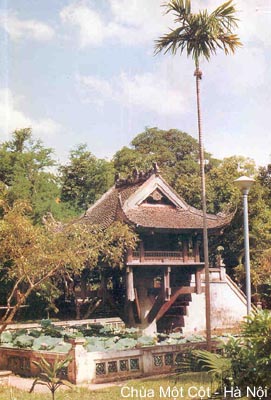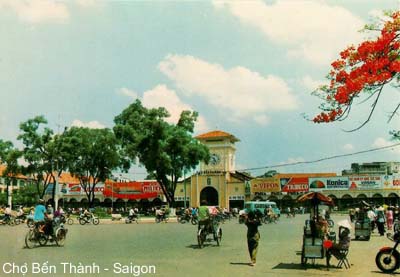

| H O M E | HISTORY | GEOGRAPHY | LANGUAGE | CITIES | PEOPLE | SCENERY |

Ha Noi, capital city of Viet Nam, in the northern part of the country, about 140 km (about 85 mi) from the Gulf of Tonkin. The city is located on the west bank of the Red River, in the middle of the fertile river delta of the same name. In the fall of 1010, King Ly Thai To (Ly Cong Uan) moved the capital from Hoa Lu to Dai La. On the way, the king saw a vision of a golden dragon ascending from the Red river ( song Hong). The King decided to change Dai La to Thang Long (Ascending Dragon). Thang Long remained the capital city until the end of the Tran dynasty when in 1397, the capital city was moved to Thanh Hoa -Tay Do (Western Capital) and Thang Long became Dong Do (Eastern Capital). Vietnam was invaded by China in 1407, and the city was renamed Dong Quan. In 1428, after ten years of fighting, Le Loi liberated Vietnam and renamed the city Dong Kinh. In 1527, the city was renamed Thang Long. In 1802 when King Gia Long (Nguyen Dynasty) moved the capital city to Hue, the name Thang Long remained but, Long no longer means dragon, Long in this case means prosperity. Ha Noi, was the name given to the city by King Minh Mang in 1831. Ha means river and Noi means within - Ha Noi means within the river. Most Vietnamese and Westerners are familiar with the phrase Ha Noi 36 districts. This phrase often causes much confusion for most people since, on the one hand "Pho" means a street or a place for merchants to gather to do business, and "Phuong" means a district or a guild of artisans specializing in a particular trade. Today, the 36 pho or old district remains in Vietnamese literature as a quaint and familiar description of this part of Ha Noi. Although many of the streets no longer have the products for which they were named, some still do. Today, on many of the streets, there are still shrines dedicated to the individual diety of the trades for which the streets are named.
|
Hue, city, central Viet Nam, Located 660 km from Ha Noi and 1080 km from Saigon, Hue has always been considered the fulcrum of Vietnam's two rice baskets, the Red river delta and the Mekong delta. Hue is an important trade center. The agricultural area surrounding the city produces rice. Industries include the manufacture of textiles and cement. Founded about the 3rd century BC, Hue was the capital of the Annamite Empire and the site of the imperial Annamese palace. Beyond the city walls are the tombs of past emperors. After the French established a protectorate over Annam in 1884, Hue was the capital of the protectorate until 1946. During the Viet Nam War, the Battle of Hue took place between January 31 and February 29, 1968; units of U.S. Marines and South Vietnamese troops drove North Vietnamese forces from the city. Many historical and cultural treasures were destroyed during the conflict. Since the 16th century, Nguyen Lord chose this area to be their headquarters. Nguyen Anh made it Vietnam's capital city in 1802 after he defeated the Tay Son and ascended to the throne with the name Gia Long. King Gia Long (1762-1819) was credited for building and fortifying Hue from the very beginning. Since then, successive king of the Nguyen Dynasty has added to the foundation set by his predecessors.
Although Hue has sustained much damage from natural disasters and wars,
the city and
|
Saigoncity
in southern Viet Nam, on the Saigon River, near the fertile Mekong delta.
The country's largest city.
 Like many cities in Vietnam, Saigon did not escape from the war. Saigon has had quite a traumatic history. There are many citations to the birth of Saigon and the origin of its name. In the 15th century, this area were swamps, marshes and thick forests. By the early 17th century, a small township was formed. The name "Saigon" was used officially in 1698, when Lord Nguyen Phuc Chu sent Nguyen Huu Canh to this region to create various districts and to form a government for this southern outpost. Because of its strategic location for trade and commerce as well as military importance, Saigon continued to grow and became a bonafide city. Mid 19th century, the French with the aid of the Spanish invaded this port city and destroyed the fort. This event was the precursor to the long struggle between the people of Vietnam and France leading to the historical defeat of the French in 1954.
In the 60's and 70's, Saigon was bustling with commerce and business. It
was the cultural
After
the fall of South Vietnam to communism in 1975. The new government renamed
the city Ho Chi Minh City. Although recognized world wide as Ho Chi Minh
City, to the people of Vietnam, the city is still lovingly referred to
as Saigon.
|
| H O M E | HISTORY | GEOGRAPHY | LANGUAGE | CITIES | PEOPLE | SCENERY |
Copyright © 2000 Vietnam's My Country Group